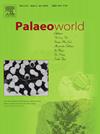Glabrobournonia Morris and Skelton (Rudist, Bivalvia) from the Campanian–Maastrichtian of Türkiye: Taxonomy, palaeoecology and palaeobiogeography
IF 1.7
3区 地球科学
Q2 PALEONTOLOGY
引用次数: 0
Abstract
A re-examination of the specimens described as Bournonia anatolica Özer and Bournonia sp. from central and southeastern Anatolia, Türkiye reveals that they have diagnostic characteristics of the genus Glabrobournonia Morris and Skelton. New rudist material from the middle Campanian to late Maastrichtian mixed siliciclastic-carbonate sequences in the Sakarya Zone (Eastern and Central Pontides), in the east of the Anatolid–Tauride Block and in southeastern Anatolia (north of the Arabian Platform) in Türkiye also showed the occurrence of Glabrobournonia anatolica (Özer) and Glabrobournonia arabica Morris and Skelton. Glabrobournonia anatolica is characterised by a large, rectangular right valve with pronounced growth lamellae, a salient ventral carina and interband, a less salient dorsal carina, a concave indentation anterior band, a slightly concave posterior band and broad and smooth anterior surface as well as the absence of radial ribbing and ligamentary infolding. Glabrobournonia arabica has the diagnostic features of the species, such as small valves, conical right valves with a smooth surface, ventral and dorsal carinae and two concave indentations of anterior and posterior bands separated by an interband. The palaeoecological characteristics of these lateral clinger morphotypes are presented according to growth geometries. For the cosmopolitan genus Glabrobournonia, two main migration routes have been proposed for the Campanian–Maastrichtian time: one along the southern margin of the Tethys from the United Arab Emirates–Oman border region to the Zagros (Iran) and southeastern Anatolia, connecting to the northern margin of the Tethys to the Anatolid–Tauride Block and the Sakarya Zone in Türkiye, and another from the United Arab Emirates–Oman border region to the Zagros Zone (Iran) and the Tarim Basin, connecting the northern and southern margins of the eastern Tethys.
来自比利时坎帕尼亚-马斯垂克地区的Glabrobournonia Morris和Skelton (Rudist, Bivalvia):分类学、古生态学和古生物地理学
对来自安纳托利亚中部和东南部的Bournonia anatolica Özer和Bournonia sp.的标本重新检查,rkiye发现它们具有Glabrobournonia Morris和Skelton属的诊断特征。在基叶地区的Sakarya带(东、中Pontides)、Anatolid-Tauride地块东部和Anatolia东南部(阿拉伯地台北部),来自中坎帕尼亚至马斯垂克晚期混合硅屑-碳酸盐层序的新rudist材料中也发现了Glabrobournonia anatolica (Özer)和Glabrobournonia arabica Morris和Skelton。其特征为大而长方形的右瓣,生长片明显,腹侧隆突和带间突出,背侧隆突不太突出,前带凹陷,后带微凹,前表面宽而光滑,无径向肋和韧带内折叠。arabica Glabrobournonia arabica具有该物种的诊断特征,如小瓣,表面光滑的圆锥形右瓣,腹侧和背侧的隆突,前带和后带的两个凹痕被带间分开。根据生长几何形状,给出了这些侧向黏附形态的古生态特征。对于世界性的Glabrobournonia属,在坎帕尼亚-马斯特里赫特时期提出了两条主要的迁徙路线:一条沿着特提斯的南缘,从阿拉伯联合酋长国-阿曼边境地区到扎格罗斯(伊朗)和安纳托利亚东南部,连接特提斯的北缘到阿纳托利德-塔乌里德地块和基耶的萨卡里亚地区;另一条从阿拉伯联合酋长国-阿曼边境地区到扎格罗斯地区(伊朗)和塔里木盆地,连接特提斯东部的南北边缘。
本文章由计算机程序翻译,如有差异,请以英文原文为准。
求助全文
约1分钟内获得全文
求助全文
来源期刊

Palaeoworld
PALEONTOLOGY-
CiteScore
4.00
自引率
5.90%
发文量
95
期刊介绍:
Palaeoworld is a peer-reviewed quarterly journal dedicated to the study of past life and its environment. We encourage submission of original manuscripts on all aspects of palaeontology and stratigraphy, comparisons of regional and global data in time and space, and results generated by interdisciplinary investigations in related fields. Some issues will be devoted entirely to a special theme whereas others will be composed of contributed articles. Palaeoworld is dedicated to serving a broad spectrum of geoscientists and palaeobiologists as well as serving as a resource for students in fields as diverse as palaeobiology, evolutionary biology, taxonomy and phylogeny, geobiology, historical geology, and palaeoenvironment.
Palaeoworld publishes original articles in the following areas:
•Phylogeny and taxonomic studies of all fossil groups
•Biostratigraphy, chemostratigraphy, chronostratigraphy
•Palaeoecology, palaeoenvironment and global changes throughout Earth history
•Tempo and mode of biological evolution
•Biological events in Earth history (e.g., extinctions, radiations)
•Ecosystem evolution
•Geobiology and molecular palaeobiology
•Palaeontological and stratigraphic methods
•Interdisciplinary studies focusing on fossils and strata
 求助内容:
求助内容: 应助结果提醒方式:
应助结果提醒方式:


